Pharmacognosy, Phytochemical and Pharmacological Potential of Sacostemma acidum Voigt
Abstract
Full text article
References
Gupta S and Kohli S: Folklore uses of an endangered ethnomedicinal herb of India Sarcostemma acidum. (Somlata), Formavita 2010.
Pandey Sandeep: Ethnomedicinal Potential of Sarcostemma acidum in different Regions in India. Asian Journal of Pharmaceutical and Clinical Research 2018; volume 11, issue 5, pp 395-400.
Bhavesh kumar: Pharmacognostical study of a medicinal plant of India-Sarcostemma acidum. International Journal of Pharmacognosy and Phytochemical Research, 2014-15, 6(4),pp 690-697.
Dave BK, Dhirawat R, Kumawat M: Pharmacognostical study of a medicinal plant of India Sarcostemma acidum. Int J Pharm Phytochem Res 2014, 6,pp 690.
Verma PK, Sharma A, Mathur A, et al: Sarcostemma acidum stem extract on spermatogenesis in male albino rats. Asian J Androl 2002, 4, pp43-47.
Rathore MS, Shekhawat NS: In vitro regeneration in Sarcostemma acidum (Roxb.) - an important medicinal plant of semi-arid ecosystem of Rajasthan, India. Physiol Mol Biol Plants 2013, 19, pp 269-75.
Gulshan, M.D., Vijay Kumar, B., Ramarao N. et al: International Research Journal of Pharmacy.2017, 8 (6), pp 91-94.
Sangh Partap., Saurabh Kumar., et al: Journal of Pharmacognosy and Phytochemistry. 2012, 1(2), pp 27-31.
Kokate CK: Practical Pharmacognosy, 4th edition, Vallabh Prakashan, 2005:112-121.
Khandelwal K.R.: Practical Pharmacognosy, Thirteenth edition 2, Nirali Prakashan, Pune,2005:149-155.
Authors
Copyright (c) 2023 International Journal of Research in Pharmaceutical Sciences

This work is licensed under a Creative Commons Attribution-NonCommercial-NoDerivatives 4.0 International License.





